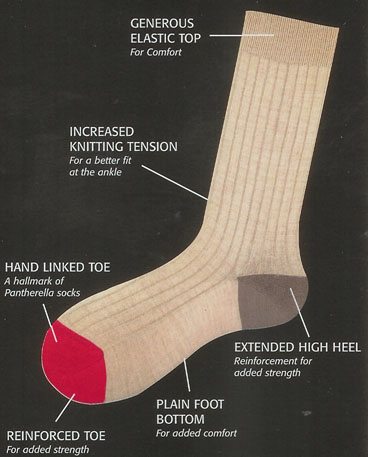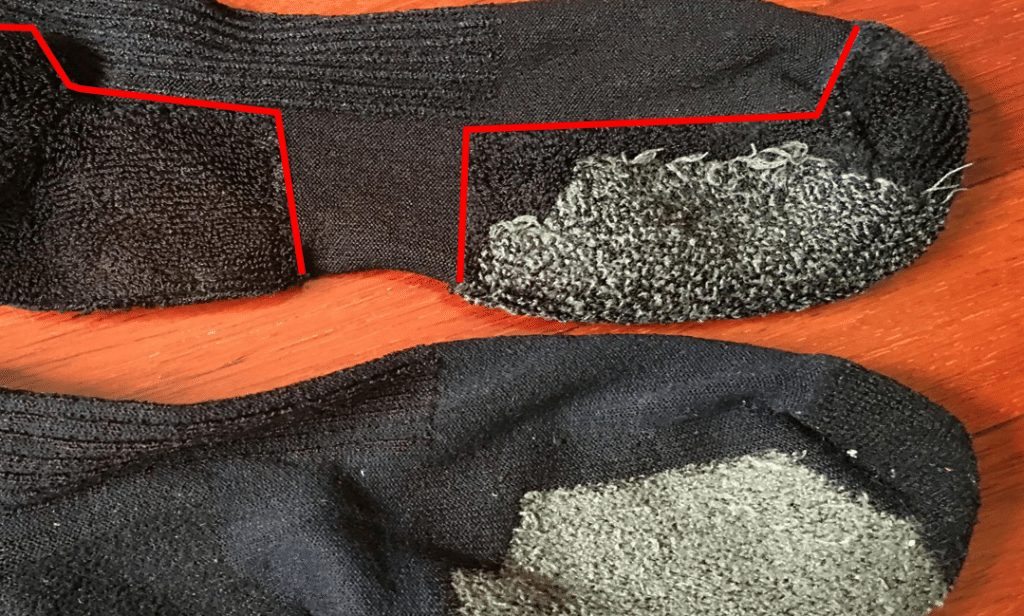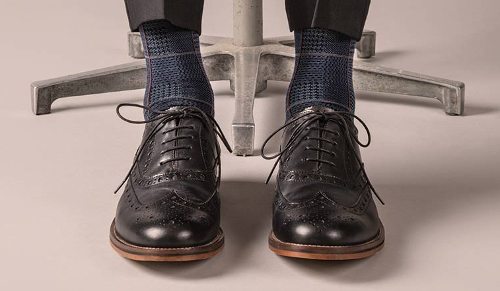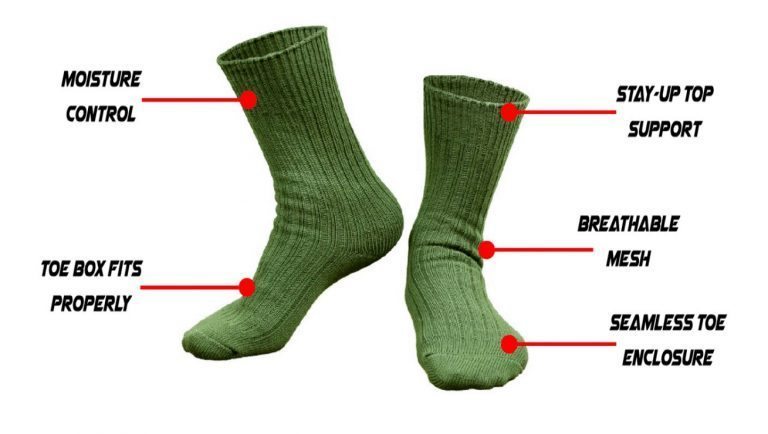- What are the best socks for my feet?
- Synthetic or Wool socks?
- Thick or thin sock?
- High versus a Low cut sock?
Good questions. It’s going to depend on a few things. The answer depends on the kind of activity that you are going to perform, the type of foot shape you have, and the footwear you use.
- First determine what kind of activity you’re going to participate in: are you going to use it for hiking with boots, running with shoes or for walking with sandals? Hiking in boots might demand thicker socks that have good heel, calf support and forefoot padding. Running in shoes might require that you find a good, lightweight fit that wicks moisture away from the foot and has arch support and foot padding. A sandal might require a standard sock that protects the feet from debris and chill, but doesn’t necessarily have to be a tailored fit such as the Injinji 5 toed socks. If you’re running in sandals, maybe a 5 toed Inkinji sock will work.
- Also consider the elements outside. Will you be running in the snow? You might look for a sock that’s good for a cold day that is comfy, thick and warm (perhaps a Merino Wool) and won’t feel itchy.
- You need to find the best fit for your foot. Make sure you’re fitted with the proper size sock-wear. You don’t want a sock too loose or it can bunch up under your foot or at the toes. And if it’s too small, it can compress the toes, and you get friction problems and lack of toe movement. Get your feet measured. Often, people who are not properly fitted end up in sock sizes that are too small or to big.
- Also, make sure you’re fitted with the proper footwear. Good socks fitted properly on a foot while wearing poorly fitted footwear could still cause problems. Depending on the shape and health of your foot, you should consider all of the options, before buying a pair of socks. Some people may require a more padded heel and forefoot in their sock, while others are fine with a light weight model, without those same features.
There are so many options out there. It can be confusing. The majority of the top sock brands on the market should meet your sock needs. There isn’t a sock on the market that offers all of the features I’ve listed but you can find some that are pretty close. In the end, a good fitting pair of socks and shoes can get you into some excellent runs, and have you thinking less about discomfort. Boot socks should certainly meet the same criteria. Going on patrols, or casually hiking shouldn’t be painful to do.
First, I’ll list many of the features that high quality socks should come with.
Second, I’ll list a few of the popular sock models on the market so you get a sense of what is out there. Much of what I list for running sock features can be applied to boot socks as well. Again, you might not be able to find everything you want, but you can still find great socks. Look for socks that serve your purpose. Although this post covers mostly running socks via my pictures the concept still holds when purchasing boot socks; look for plenty of the same quality features.
Socks should have some of these features:
- Anatomical Design: Many sock manufactures offer socks tailored for the left and right foot. The left sock can only go on the left foot, and the right sock on the right foot. This is a big plus for getting a good fit.
- Breathability: Some type of breathable mesh air vents which allows your feet to feel cooler. Some socks on the market offer open stitching, similar to a window-pane cut into the sock; the sheer material offers a lot of breathability.
- Compression: Compression-zones gives you good support in areas such as the arch and the mid-foot for a better fit and support. They should hug, without feeling restrictive, and shouldn’t bunch up under your feet.
- Contoured Fit: Not only does the sock come marked as left and right side, but the overall cut of the sock cradles your foot and the compression fits rightly on the areas that are necessary to cushion. (Heel and Forefoot).
- Cushioning: You want good padding, especially for those runner/walkers who are fore-foot or heel strikers. How much foot shock does the sock absorb? Also look for a bit of padding on the top area of the toes for protection against friction.
- Fast Drying: A fast drying sock means you might not have friction problems after you cross a stream, or get caught in a rain-soaked run or hike.
- High versus Low: Depends on the fit of the shoe or the boot. You don’t want too much of your ankle/Achilles exposed to the shoe collar. And a boot sock that is too short in a boot also means the boot laces may apply pressure along your shins. Buy socks that you might potentially be able to roll down over the collar of the boot. Look for ankle socks with padded non-slip tabs on the tongue and heel. This will prevent the sock from slipping inside your shoe.
- Longevity: Will the sock hold up to lots of wear and washing? Some brands hold up better than other brands. Abrasion resistance extends the life of your sock.
- Merino Wool. Wool is warm and has good wicking ability. Wool is general more resistant to odor, although many synthetic sock materials have anti-microbial fibers and can be somewhat odor resistant too. Wool is often blended with synthetic fibers to increase the strength and abrasion resistance of the sock. Wool also has great insulation properties.
- Moisture Control: Transports moisture from the bottom of your foot up and out of your shoe. You want something in a sock that has really good wicking ability.
- Needle Count: A good, high needle count combined with a good material means you can get a quality performance sock. Lightweight and sheer means you can get a more anatomical sculpted fit to your foot.
- No Slip: A good no-slip grip construction prevents blisters from occurring.
- Options: Color options and styles. You might want a low-cut, crew cut or a high ankle version. Larger companies can provide more color and style options, but smaller companies often offer better quality control, fit and unique one of a kind designs.
- Proper Fit: A sock that is too tight on the toe box can restrict your toe movement. On the other hand, if it’s loose then you can get bunching and blisters.
- Seamless Toe Closure: This reduces blisters from friction because you get a perfectly flat toe. You don’t want to feel the seams, and you don’t want to get bunching.
- Source: How much consistency is there in the product?
- Synthetic or Non-Synthetic Sock, Feel and Texture. What do you prefer? Some wool socks are itchy, so look for something that’s comfortable on your skin. But natural fibers can shrink a bit in the dryer. Some manufactures offer completely natural fibers that work well but you can also find multi-fiber blends as well, that could work for you and keep you under budget. Winter weather running demands a more substantial sock that keeps your feet and ankles protected.
- Value: Is it a good price to pay for the wear and tear you’re going to inflict on that sock? Is it justifiable to pay $20.00 per pair or can you do with a $12.00 to $15.00 dollar sock? In a sense, can you get two for $24.00 or one for $20.00?
- Weight: Lightweight, Mid-weight and Thicker. Find a sock that fits your foot but make sure the sock works with the footwear you select.
My own personal choice is to go with a lightweight wool/poly blend. The natural fiber doesn’t hold an odor like a synthetic material can. As the synthetic sock begins to break down it will begin to retain more of the odor, whereas a wool sock won’t. I like a bit of cushioning but not too much. I don’t prefer a lot of padding on the heel because it makes the heel strike feel too spongy for me.







